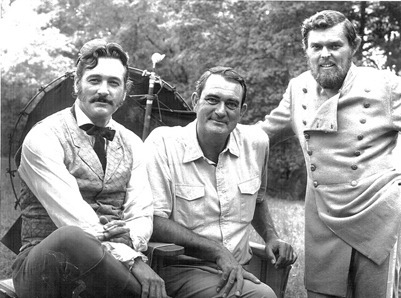Stephen B. Armstrong has over 1,000 movies in his collection, but one little known film “Breakthrough,” captured his attention. He was struck by the combination of thrilling and sorrowful scenes.
The movie led him to the director, Andrew V. McLaglen and he began watching more of McLaglen’s films and television work, intrigued by the subtle contradictions in his films like the dashing Roger Moore cast as a degenerate or the “good guy” Jimmy Stewart playing a convict.
“I realized that he is one of Hollywood’s most undersung directors,” said Armstrong. “And so to help remedy that, I wrote this book ‘Andrew V. McLaglen: The Life and the Hollywood Career.’”
You can meet Armstrong and Mclaglen at Griffin Bay Bookstore on Saturday, Sept. 3, 7 p.m. to sign copies of the book chronicling the director’s life.
McLaglen and Armstrong will begin the evening with a presentation on the director’s lengthy career, screening clips from two of McLaglen’s best films, “Shenandoah” and “Fools’ Parade.”
A home to come home to
He may be unsung for some, but here on San Juan, Mclagen is a famous character.
“He’s revered as a director and as a wonderful guy,” said San Juan Community Theater Director Meritt Olsen, who has spent many afternoons in McLaglen’s presence listening to stories about the film business.
McLaglen built his house on San Juan in 1977, but continued to work on films in exotic places in Europe, Africa and Asia.
“This was my home to come home to,” McLaglen said.
He first found out about the islands while on a Dude Ranch in Wyoming when a friend described the scenery. McLaglen thought he had to see it for himself.
“I always loved the countryside, seeing cattle in the field,” McLaglen said. “It’s a nice little town and has beautiful surrounding areas.”
After he retired as a movie director, he tried his hand directing numerous plays at the San Juan Community Theatre.
“This little theater is way beyond what a population of this size should have,” said McLaglen. “The numbers of actors and singers on the island would surprise you, it’s really first rate. Who knows I still might do another.”
A “shocking” amount of work
“The book is a wonderful tribute to his work,” said Olsen, who learned some new things about McLaglen. “The amount of stuff he has done is shocking.”
McLaglen has more than 30 credited feature films to his name and has the record for directing the most episodes of “Gunsmoke.”
Armstrong said many of McLaglen’s greatest works are overlooked because during the 60s, McLaglen used the traditional style of filming he learned in the 40s and 50s.
According to Armstrong, other directors were redefining the way movies were filmed and pushing the envelope with violence and even pornographic themes.
McLaglen’s movie had more subtle ways of looking at the time period, like in the 1969, film “The Undefeated” where John Wayne played a veteran soldier hired out as a mercenary.
At one point Wayne’s character says, “It’s a war we don’t belong in,” which Armstrong said could be perceived as a reference to Vietnam.
Armstrong said McLaglen films made you think about things in a different way and explore issues like race, authority and freedom.
In preparation for the book, Armstrong watched McLaglen’s 30 feature films, dozens of movies that McLaglen worked on as an assistant director and 100’s of his TV shows.
For more than a year, Armstrong searched for old films at garage sales, closure of video rental stores, Amazon and Ebay.
Every night Armstrong planted himself in front of the TV to watch McLaglen’s work on shows like “Perry Mason” and “Gunsmoke.”
“It’s kind of a strange thing to be knowledgeable about,” said Armstrong, but noted it’s another way to examine different historical topics like the civil rights movement, the Red Scare, and the atomic bomb.
Writing the book
Armstrong, an associate professor of English at Dixie State College in St. George, Utah, initially contacted McLaglen for a magazine article.
During that first conversation, Armstrong described McLaglen as “very entertaining and very nice.”
It was also during that conversation that Armstrong spontaneously asked McLaglen how he would feel about having a book written about him.
“I thought, ‘There needs to be a book about a character like this,’” said Armstrong.
So he started writing and eventually flew to Friday Harbor.
He remembers seeing McLaglen for the first time as “the colossus of Friday Harbor (McLaglen is 6’7”)” sitting in his chair by a sliding glass door as the rain poured outside and bald eagles soared through the sky.
Over the next three years, McLaglen said there was lots of “reading and talking.”
“He hasn’t left anything out, lets just say that,” said McLaglen with a chuckle. “He’s done a very thorough job.”
McLaglen said he can recall those days “pretty well,” even at the age of 91 and he said he doesn’t have regrets of movies he didn’t direct and he doesn’t really miss it.
“It’s a great remembrance of it,” McLaglen said. “But I had my time of doing it.”
As a boy, Armstrong remembers watching McLaglen’s most famous works like “Shenandoah” and “McLintock!”
Now as an adult he uses those films to tell the history of one man’s life whose films Armstrong describes as “worth watching over and over again.”




